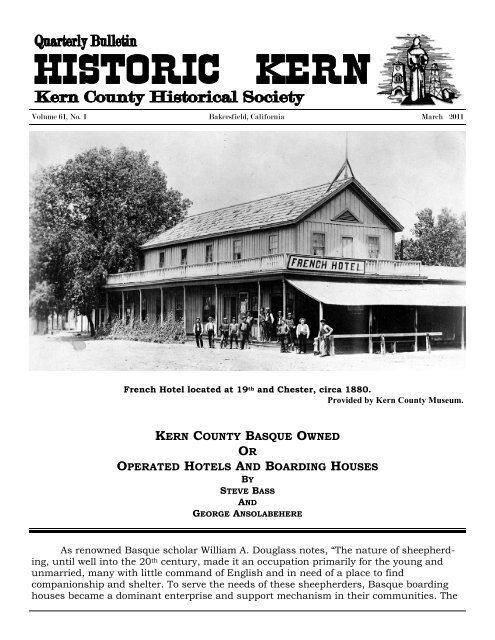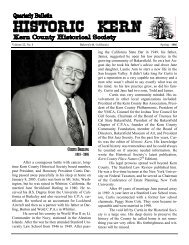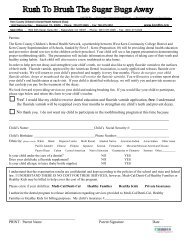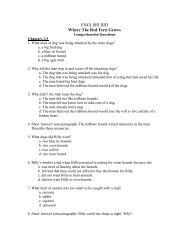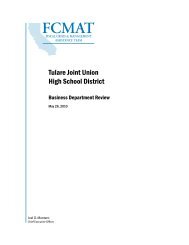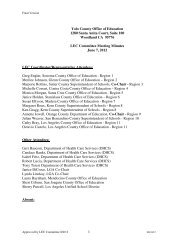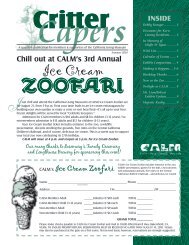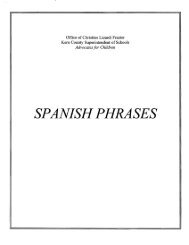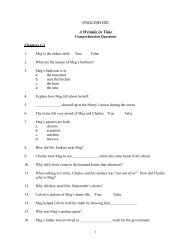kern county basque owned operated hotels and boarding houses
kern county basque owned operated hotels and boarding houses
kern county basque owned operated hotels and boarding houses
You also want an ePaper? Increase the reach of your titles
YUMPU automatically turns print PDFs into web optimized ePapers that Google loves.
Projeto: “O Policiamento que a Sociedade Deseja”Análise das Discussões em Grupo com praças da PolíciaMilitar de São PauloAdriana LocheO grupo de praças da Polícia Militar foi composto por 11 policiais militares, das trêspatentes da categoria, que trabalham no patrulhamento de área de diversas regiões dacidade, abrangendo desde os bairros mais ricos até os mais pobres do município.Estavam presentes quatro soldados, três cabos e quatro sargentos. Ou seja, houve umequilíbrio entre as três patentes que compõem a categoria dos praças e não houvenenhum constrangimento pelas diferentes hierarquias.Em um primeiro momento, a discussão ficou pautada nas dificuldades que ospoliciais enfrentam no seu cotidiano, dificuldades estas relacionadas à falta de recursosmateriais e humanos, e também à inadequação da política de segurança pública adotadapelo governo de Estado.Na percepção dos policiais, as queixas apresentadas não se configuram como“revolta”, mas como problemas que devem ser abordados ao se tratar do relacionamentoentre a polícia e a comunidade, pois as dificuldades enfrentadas pelos policiais serefletem negativamente no relacionamento que será estabelecido.“Notem que o nosso tema aqui é polícia e comunidade, mas tudoisso que a gente está fal<strong>and</strong>o não é revolta não. Tudo isso interferena relação lá fora”.De todos os policiais presentes, apenas um deles se declarou satisfeito com o seutrabalho em razão de estar lotado em um batalhão diferenciado, que investe no policial.Este policial afirmou que, como os demais, seu batalhão sofre da falta de recursosmateriais, mas isto é compensado pelo investimento que há no policial.O que pode ser depreendido do grupo é que há uma gr<strong>and</strong>e insatisfação quantoao seu trabalho, por razões diversas que vão desde a falta de recursos materiais até afalta de reconhecimento institucional, pass<strong>and</strong>o também pela indefinição de qual é o seupapel na área de segurança pública.1. Relacionamento com a população1
owner of the <strong>boarding</strong> house served as interpreter, postmaster, medical advisor, <strong>and</strong>business consultant for Basque newcomers to the American West. Boarding <strong>houses</strong> alsoprovided traditional music, held dances, <strong>and</strong> constructed pelota <strong>and</strong> jai alai courts fortheir patrons, making them the focus of social life in many Basque communities.” KernCounty was no exception to this phenomenon with three communities having at least onesuch establishment. Bakersfield had seven <strong>hotels</strong>, one with a pelota court. Tehachapi withfive <strong>hotels</strong>, one with a pelota court while McKittrick had a hotel only.In 1890, Fern<strong>and</strong>o Etcheverry came to the Bakersfield area from Aldudes,Basse-Pyrenees. He soon went into the sheep business <strong>and</strong> made his headquarters in thePoso Creek area <strong>and</strong> then in Kern, now called East Bakersfield. In 1893 Etcheverry <strong>and</strong>Faustino Mier Noriega opened the Iberia Hotel in Kern. Faustino Mier was from Sant<strong>and</strong>er,Spain, <strong>and</strong> came to the U.S. to work for his uncle, Vincente Noriega, in Tulare. Faustinoadopted his uncle’s surname as his own <strong>and</strong> in 1893 married Basque Louise Inda.Faustino <strong>and</strong> Louise had five children, Marcellena, Julia, Christina, Frank <strong>and</strong> Albert <strong>and</strong>lived in a large house they had built on Baker Street. The house, elegant <strong>and</strong> well kept, isnot in the family now but it is still known as “The Noriega House.” Frank became the firstof several Basque judges in the <strong>county</strong>.In 1901, Etcheverry <strong>and</strong> Noriega then built the Pyrenees Hotel just one block east ofthe Iberia <strong>and</strong> began leasing out the operations of their <strong>hotels</strong>. Between 1901 <strong>and</strong> 1906Noriega <strong>and</strong> Etcheverry leased the Iberia to Jean <strong>and</strong> Jeanne Burubeltz. Jean Burubeltzwas also one of the earliest Basque residents of Kern County, arriving in 1873.In 1906, while still in partnership with Etcheverry, Noriega changed the name of theIberia to the Noriega Hotel. Etcheverry sold his interest in the hotel to Noriega severalyears later <strong>and</strong> began concentrating his energies on ranching.In 1906, the Burubeltz family moved from the Noriega Hotel to operate the Hoteld’ Europe (also known as the Europa) <strong>owned</strong> by Pierre Roux. The hotel was located onSumner Street between the Metropole, at Baker <strong>and</strong> Sumner, <strong>and</strong> Noriega’s. Jean died in1911 <strong>and</strong> Jeanne continued to run the hotel. In 1915 she purchased it from Roux <strong>and</strong><strong>operated</strong> it until 1921 when it closed.The French colony in the early town of Kern also had several <strong>hotels</strong> in the Sumner<strong>and</strong> Baker area. The Hotel de Alpes <strong>operated</strong> by Jules Jaussaud <strong>and</strong> August Dusserre wasat 723 Humboldt. (The Hotel de Alpes building was the original Kern City French Bakerybuilding, now at the Kern County Museum’s Pioneer Village, <strong>and</strong> Humboldt Street is nowEast 19 th Street.) Louis Chauvet <strong>and</strong> Virgil Grimaud <strong>operated</strong> the Universal Hotel at711Humbolt <strong>and</strong>, finally, there was the Plantier Hotel at 631 Humboldt <strong>and</strong> the FrenchHotel at 19 th <strong>and</strong> M Streets.Also at 19 th <strong>and</strong> M Streets was the Occidental Hotel, located upstairs aboveBakersfield Feed <strong>and</strong> Seed. At one time Basque Jean Pierre Martinto <strong>operated</strong> it. In 1910 ithad originally been a saloon but when Prohibition began in 1920 it became a feed store<strong>owned</strong> by Martinto <strong>and</strong> his partners Auguste Ariey <strong>and</strong> Auguste Michel. Martinto came tothe U. S. at the age of 16 <strong>and</strong> to Kern County in 1888 to herd sheep for his brother JeanFermin. Jean Pierre became a successful hotel owner in Tehachapi in 1895 <strong>and</strong> thenretired in Bakersfield.A lesser-known Basque-<strong>owned</strong> hotel was the National. It was located at the corner ofBaker <strong>and</strong> Humboldt Street <strong>and</strong> was <strong>owned</strong> by Pierre Sartiat <strong>and</strong> his brother Bernard,both among the first permanent Basque residents of Kern County. Pierre’s son, PierreBernard, <strong>operated</strong> the hotel.Another Basque-<strong>operated</strong> hotel, the memory of which has faded, was the East SideCommercial Hotel that was located at 713 1/2 Sumner Street, south of the SouthernPacific railroad depot. Jean <strong>and</strong> Grace Laporte Elizalde ran it in the 1920’s before they
took over the Noriega Hotel in 1931.The Metropole Hotel, located at Sumner <strong>and</strong> Baker Street, was Basque <strong>operated</strong>until the 1930’s. It was first run by Jean Estribou <strong>and</strong> then by Jacque <strong>and</strong> Grace Iriart.Jean Estribou was from Ogeu, in the Basse-Pyrenees <strong>and</strong> first came to San Francisco in1882 <strong>and</strong> worked at various trades. He then relocated to Kern in 1893 <strong>and</strong> in 1895 heopened the Metropole market <strong>and</strong> hotel. He also raised cattle <strong>and</strong> alfalfa on his ranchsoutheast of town. He built <strong>and</strong> ran a slaughterhouse on the same property. In 1912 hesold the retail market but continued with the wholesale beef business <strong>and</strong> opened theEstribou delicatessen in the Metropole building.Francisco (Frank) Amestoy was born in Irurita, Spain <strong>and</strong> came to SouthernCalifornia after working in the Philippines on a sugar plantation with his two brothers. Hemoved to Bakersfield <strong>and</strong> found employment at the Noriega Hotel. It was there he met hisbride-to-be, Anselma Ballaz. Anselma was from the same province as Frank <strong>and</strong> had beenemployed at the Noriega as a maid since 1912. Frank <strong>and</strong> Anselma, who was also knownas Chaparita, purchased the Cesmat Hotel on East 21 st street, in 1927. They bought iteven though they had been operating the Noriega since 1920. In 1931, they left theNoriega Hotel <strong>and</strong> took over the Cesmat <strong>and</strong> changed its name to the Amestoy Hotel.Chaparita was well known for her feisty personality. It is rumored that if someonemade trouble in the bar she would chase the offender out of the place with a meat cleaver.In addition, local lore has it that during Prohibition almost any Basque hotel had a supplyof wine stashed somewhere on the premises to be served on special, or even not so special,occasions.Early on, Basques came to Kern County, basically, in three ways. They sailedaround the southern tip of South America, sometimes stopping for years in Argentina orChile, <strong>and</strong> then continuing the trip by ship to Mexico, Los Angeles or San Francisco.Secondly, they sailed to the Isthmus of Panama, walked or took a train across the isthmusto the Pacific, <strong>and</strong> then sailed north to Los Angeles or San Francisco. Lastly, they sailed toEllis Isl<strong>and</strong>, New York <strong>and</strong> took a train, or in a few instances, walked, across thecontinent. Taking the train to Bakersfield meant that they finished their journey at theSouthern Pacific depot, one block from the Noriega Hotel. Since the great majority of theseimmigrants did not speak English, many came all the way across the country with simplya note attached to their lapel that stated: “Noriega Hotel, Bakersfield, California.” As soonas they departed the train, someone would point them down the street to the hotel. TheNoriega Hotel’s importance to the Kern County Basque community cannot be overstated.The Noriega became the destination, clearing house, social center <strong>and</strong> mailingaddress for many Bakersfield Basques <strong>and</strong> was instrumental in their assimilation intolocal society. Many of the early Basque women found employment as maids at the hotel. Inaddition, through dances <strong>and</strong> social functions many Basques met their future bride orgroom at the hotel.Jean Elizalde, from Anhaux, France came to Bakersfield in 1905 as a sheepherder.He herded sheep for various employers <strong>and</strong> then purchased his own flock. Gracianne(Grace) Laporte was also born in Anhaux <strong>and</strong> came to Tehachapi in 1914. Shortlythereafter, while working at the Franco-American Hotel for family friend Jacques Iriart,she met Jean <strong>and</strong> they were married. They lived in various sheep camps <strong>and</strong>, after theylost their sheep during the Depression, they went into the hotel business, leasing the NewCommercial Hotel on Sumner Street. The Elizaldes took over the Noriega Hotel in 1931from Domingo Recatune <strong>and</strong> his wife Marcelina Noriega Recatune.Grace Elizalde was the unofficial godmother to all the less fortunate Basqueindividuals <strong>and</strong> families in town <strong>and</strong> she was known as “Mama Elizalde” because shewould share her time <strong>and</strong> resources with anyone she felt was needy. Her unselfish
devotion to the welfare of those not as fortunate is legendary. She continued to operate thehotel after Jean died in the 1930’s until she died in 1974. At that time, sons Albert <strong>and</strong>Louie then took over the operation of the hotel. When Louie died, his wife Janice then ranthe hotel with Albert. When Albert died, Janice was assisted by two of her daughters,Rochelle Ladd <strong>and</strong> Linda McCoy. Since Janice died, Rochelle <strong>and</strong> Linda have <strong>operated</strong> thehotel. It has now been in the Elizalde family for almost eighty years. It remains aBakersfield <strong>and</strong> national l<strong>and</strong>mark. Grace Laporte Elizalde was inducted into the BasqueHall of Fame in New York in 1998.Tehachapi also became a relatively large Basque center <strong>and</strong> had several Basque<strong>hotels</strong>. The earliest, the Piute, was built in 1893 <strong>and</strong> <strong>operated</strong> by Austin Young <strong>and</strong> hisBasque wife, the former Marianne Goyehen. It burned to the ground in 1895. Also in 1895,Jean Pierre Martinto, (mentioned previously) with financial help from his brother JeanFermin, built the largest hotel in town, the Basses-Pyrenees, which also featured ah<strong>and</strong>ball court. The hotel was named for the area of the Basque Country the Martintoswere from.Jean Pierre leased the Basse-Pyrenees to Vincente Iriarte in 1908 <strong>and</strong> changed thename of the hotel to the Martinto Hotel. After leasing-out the hotel, the Martinto’s leftTehachapi <strong>and</strong> settled on their forty-acre farm near Bakersfield.Another hotel, the Cesmat, was built in the late 1890’s. John Iribarne <strong>and</strong> his wife,the former Mary Goyehen, sister of Marianne, ran the hotel from 1900 to 1903.Juanita Hotel located at Tehachapi, circa 1930.Provided by Kern <strong>county</strong> Museum.
Pierre (Pete) Errecart came to Kern County from Anhaux, France in 1916. Hemarried Marie Irouleguy, from Urepel. The Errecarts ran another mountain hotel, theTehachapi, in the late 1920’s. Pete died in Tehachapi in 1933. Marie then settled inBakersfield in the early 1930’s. She died in December 1937.Widow Hortense Anchordoquy Heguy married Francisco Ciaurritz <strong>and</strong> they took overthe Tehachapi Hotel from Marie Errecart. Later, in the early 1940’s Anchordoquy-Heguyran the Tehachapi with relative Peo Anchordoquy. Hortense was one of eleven children <strong>and</strong>never met her two older brothers as they moved to Argentina before she was born.In 1896, George Esponda built the Basko Hotel. He had married the widow MarieAlzuet Borda. They sold the Basko to Jacque <strong>and</strong> Grace Iriart. In 1914, the Iriarts took ona French partner <strong>and</strong> the hotel was renamed the Franco-American.Jacque had a brother Samson (Sam) who had first gone to Uruguay before coming toTehachapi. In Tehachapi, he married Joaquina Elgart, stepsister of Grace Iriart. Sam wasin <strong>and</strong> out of Kern County afterward but returned to Tehachapi in 1920. In 1922, Jacque<strong>and</strong> Sam built the Iriart Building that contained several businesses downstairs <strong>and</strong> a hotelon the second floor known as the Juanita. The brick building was across the street fromthe Franco-American Hotel. In 1926, Jacque <strong>and</strong> Grace left Tehachapi to becomemanagers of the Metropole Hotel at Sumner <strong>and</strong> Baker in East Bakersfield. The IriartBuilding was destroyed in the earthquake of 1952 <strong>and</strong> the last Basque hotel in Tehachapiwas gone.Noriega Hotel, circa 1960.Provided by Kern <strong>county</strong> Museum.In 1903, on the westside of the <strong>county</strong>, Basque Jean Iribarne took over theMcKittrick Hotel, also known as the Old Headquarters Saloon, from Alm<strong>and</strong>o B<strong>and</strong>attini,in the thriving oil boomtown of McKittrick. B<strong>and</strong>attini had built the hotel in 1898 when
McKittrick was known as Asphalto. There, Iribarne married Bernarda Arrache. He ran thehotel until the 1930’s <strong>and</strong> it became a center of activity for the prospering westside oilindustry renting rooms, equipment, livery supplies <strong>and</strong> selling dry goods, food <strong>and</strong> drinkto early oilmen, ranchers <strong>and</strong> sheepmen. The Old Headquarters advertised “Imported <strong>and</strong>Domestic Wines, Liquors <strong>and</strong> Cigars, Feed <strong>and</strong> Livery Stable <strong>and</strong> Furnished Rooms.” TheMcKittrick Hotel is still in operation today as a cafe <strong>and</strong> bar. It remains a social center forKern County’s westside oilfields <strong>and</strong> is noted for its back room, which is entirely coveredwith pennies: floor, ceiling, walls, doors <strong>and</strong> bar.Of all the Bakersfield <strong>hotels</strong> mentioned, only the Amestoy, Metropole, Pyrenees <strong>and</strong>Noriega remain. The Amestoy building is now a restaurant called Narducci’s, the Metropoleis primarily a relic <strong>and</strong> The Pyrenees is basically a bar <strong>and</strong> restaurant. The Noriega,however, according to Basque historian Jeronima Echeverria, is the oldest <strong>and</strong> last ostatu(a Basque hotel, <strong>boarding</strong>house, restaurant, meeting place, etc.) in the world. It is the onlyestablishment that still takes in male boarders <strong>and</strong> serves family-style meals at oneseating. Through the Elizalde family, the hotel remains in Basque h<strong>and</strong>s.The Basques are just one of many different ethnic groups who came to Kern County<strong>and</strong> established successful businesses <strong>and</strong> careers. Kern’s Basque <strong>hotels</strong> <strong>and</strong> <strong>boarding</strong><strong>houses</strong> were <strong>and</strong> are just a fraction of the total of that were once scattered all across theWestern States. We are fortunate to have these ethnic groups rooted here <strong>and</strong> just asfortunate to have a last vestige of these disappearing hostelries in our area.ReferencesBailey, Richard C. An Illustrated History of Bakersfield. Woodl<strong>and</strong> Hills:Windsor Publications, 1984.Bass, Steve <strong>and</strong> George Ansolabehere. Basques in Kern County: 1870 to1940. Bakersfield, Kern County Basque Club, 2010.Boyd, Robert G. Amerikanuak! Basques In the High Desert. Bend: The HighDesert Museum, 1998.Douglass, William A. <strong>and</strong> Jon Bilbao. Amerikanuak. Reno, University of NevadaPress, 1975.Douglass, William A. <strong>and</strong> Richard Lane. Basque Sheepherders of the American West.Reno: University of Nevada Press, 1985.Echeverria, Jeronima. Expansion <strong>and</strong> Eclipse of the Basque Boarding House in theAmerican West. Nevada Historical Society Quarterly, Summer 2000.Echeverria, Jeronima. Home Away From Home: A History of Basque BoardingHouses. Reno: University of Nevada Press, 1999.Echeverria, Jeronima. “The Basque Boarding House.” Bakersfield: Mugaz GaindiInternational Symposium, October 2008.Etulain, Richard <strong>and</strong> Jeronima Echeverria. Portraits of Basques in the New World.Reno: University of Nevada Press, 1999.Laxalt, Robert. Basque Sheepherders, Lonely Sentinels of the American West.National Geographic Magazine, June 1966Morgan, Wallace Melvin. Kern County History. Historic Record Company,Los Angeles, CA. 1914.Nickell, Jeff. “Kern County’s Cultural Basque Ties.” Bakersfield Life Magazine,February 2008.Paquette, Mary Grace. Basques to Bakersfield. Bakersfield: Kern County HistoricalSociety, 1982.
The Basque Sheepherders in the West. Basque Educational Organization.Burlingame, CA, 2000.Totoricaguena, Gloria. “Early Basques in California.” Reno: Center for BasqueStudies, University of Nevada.Totoricaguena, Gloria. “Ethnic Industries for Migrants: Basque Sheepherding in theAmerican West.” Euskonews & Media, 2003.THE VAQUERO WHO FOUGHT THE DEVILBY R. W. LOUDONThis little folklore story was told to the writer in 1935 by Don Jose Jesus Lopez, whofor many years was majordomo of the Tejon Ranchos. A sixth generation SpanishCalifornian, Lopez was a highly-respected businessman <strong>and</strong> a top cattle <strong>and</strong> sheep man.The tale was not considered a joke, <strong>and</strong> while we today may have a superciliousattitude about such things, it is well for us to remember that many of our ancestors inEurope during the Middle Ages accepted this type of lore as an omen. In fact, we may attimes secure more know ledge of how the people thought by their tales <strong>and</strong> ballads thanby reading formal history. This tale, however colored by decent, is in a pattern as native asthe people who believed it.Juan Maraville, a vaquero who rode for John Funk, one of the owners of the SanEmigdio Rancho in 1870, had been acting rather queerly for some time. It was whisperedsome crime was preying on his mind. It had been noticed that he had not attended Massheld by the traveling padres for some time, although in the past he had been a goodattendant.One dark night, Juan, who slept in the little bunkhouse room at the upper ranch,dived out of the window. White <strong>and</strong> disheveled, he told in a shaking voice how a man hadstood over his bunk. The interloper had horns on his head <strong>and</strong> legs like an animal. Aterrible fight took place, with Juan at last jumping out of the room to save his life.No sign of the devil could be found at the bunkhouse, however. But ever after, Juanwas avoided. He seemed queer, almost to the point of being crazy, although he was notviolent.The Americans said he had had a nightmare, but the Spanish, Mexicans, <strong>and</strong>Indians shook their heads <strong>and</strong> said it was more than that. The supernatural had hadsome thing to do with it. Quien Sabe?Later, Juan moved to Lebec <strong>and</strong> took up a homestead southeast of the settlement.For many years, the vaqueros crossed themselves when riding by the cabin of the ManWho Had Fought with the Devil.
—Quarterly Bulletin —The Kern County Historical SocietyPost Office Box 141Bakersfield, California 93302Non-Profit OrganizationU.S. POSTAGEPAIDBakersfield, CA 93302PERMIT NO. 870Return Service RequestedPlease make checks payable to Kern County Historical Society, add $4.00 per orderfor postage & h<strong>and</strong>ling, <strong>and</strong> mail to the address below.Kern County Historical SocietyP.O. Box 141Bakersfield, CA 93302Book Price Tax TotalKern County Wayfarers (Paperback) William Harl<strong>and</strong> Boyd 5.00 .41 5.41L<strong>and</strong> Policies In Kern County (Paperback) Paul W. Gates (Passage of Public DomainL<strong>and</strong>s To Private Ownership)2.00 .16 2.16Basques To Bakersfield Mary Paquette 15.00 1.23 16.23Stagecoach Heyday In The San Joaquin Valley (1853-1878) William Harl<strong>and</strong> Boyd 5.00 .41 5.41Kern County Pioneer Recollections 18.95 1.56 20.51Kern County Place Names Second Edition Curtis Darling 18.95 1.56 20.51Historical Site Markers In Kern County (Paperback) William Hample 11.95 .98 12.93Lower Kern River Country 1850-1950 William Harl<strong>and</strong> Boyd 18.95 1.56 20.51Kern County’s Desert Country—An Historical Overview William Harl<strong>and</strong> Boyd 16.95 1.39 18.34Life On The Elk Hills Oil Field (Softcover Booklet) Cindy L. Baker 7.95 .65 8.60Chinese In Kern County, 1857-1960 — Based on pioneer oral histories 24.95 2.05 27.00Curtis Darling’s Postcard Collection Volume 1 (Paperback) Donald Arnot & Jeff Nickell 13.95 1.15 15.10Kern County Historical SocietyOfficers And ChairpersonsPresidentVice-PresidentTreasurerSecretary, CorrespondingSecretary, RecordingOne YearJohn CoddJackie BrouilletteLinda McMahonSarah WoodmanWilliam St. ClaireAuditorBook SalesC.C.H.S. LiaisonEducationHistorianHistoric KernHistorical ResearchK.C.M. LiaisonL<strong>and</strong>marksMembershipNominatingOral HistoryPrograms/ToursPublicationsPublicityReservationsWebsiteBoard Of TrusteesCommittee ChairsKen HooperKrista Morel<strong>and</strong>Gary WilcoxLisa MeehanRebecca OrfilaTwo YearMon BertolucciKitty DeArmondScott FieberBarbara JarrettRichard JarrettJeff KrausseKrista Morel<strong>and</strong>Ken HooperKitty DeArmondLori Wear & Don ArnotGilbert GiaSarah WoodmanGary WilcoxLori WearKrista Morel<strong>and</strong>Sarah WoodmanBarbara JarrettLori WearBe sure to check our web site atwww.kchistoricalsociety.org


